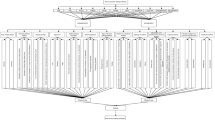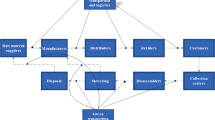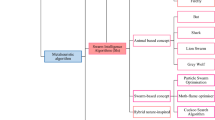Abstract
This study has proposed a methodology by enhancing an interactive algorithm to multi-objective optimization problems with interval parameters, in an attempt to reach the tradeoff between quality and reliability of the resultant optimum solutions. The earlier algorithm could turn into a prolonged procedure that deals with several players with different aspirations at different reliability, or risk, levels under non-deterministic conditions. Hence, it is not a pertinent approach to solve problems of water allocation between competing parties. The enhanced methodology aims to alleviate the burdens of the procedure and generate a unique set of solutions (i.e., near-Pareto-optimal alternatives), instead of a myriad of compromise solution sets. We have investigated a real-world hydro-environmental problem, the allocation of water between Dorudzan-Korbal irrigation networks and Bakhtegan Lake in Fars Province, Iran to assess feasibility of this methodology. In order to reach a consensus concerning the stakeholders’ individual preferences, we identified the compromise alternatives from the obtained sets of non-dominated solutions by taking advantage of various social choice rules and the Nash bargaining model. The results demonstrated that the developed methodology could incorporate the risk of system constraints violations (i.e., planning reliability under uncertainty) into the process of approximating the optimal tradeoff set of solutions. It also gave policymakers a chance to acquire perception into the potentially best compromise for land and water allocation schemes regarding the preference profiles of the involved interest groups.





Similar content being viewed by others
References
Alizadeh MR, Nikoo MR, Rakhshandehroo GR (2017a) Developing a multi-objective conflict-resolution model for optimal groundwater management based on fallback bargaining models and social choice rules: a case study. Water Resour Manag 31:1457–1472
Alizadeh MR, Nikoo MR, Rakhshandehroo GR (2017b) Hydro-environmental management of groundwater resources: A fuzzy-based multi-objective compromise approach. J Hydrol 551:540–554
Arsanjani TJ, Javidan R, Nazemosadat MJ, Arsanjani JJ, Vaz E (2015) Spatiotemporal monitoring of Bakhtegan Lake's areal fluctuations and an exploration of its future status by applying a cellular automata model. Comput Geosci 78:37–43
Colapinto C, Jayaraman R, Marsiglio S (2017) Multi-criteria decision analysis with goal programming in engineering, management and social sciences: a state-of-the art review. Ann Oper Res 251(1–2):7–40
Connor R (2015) The United Nations world water development report 2015: water for a sustainable world vol 1. UNESCO Publishing
Das B, Singh A, Panda SN, Yasuda H (2015) Optimal land and water resources allocation policies for sustainable irrigated agriculture. Land Use Policy 42:527–537
Davijani MH, Banihabib M, Anvar AN, Hashemi S (2016) Optimization model for the allocation of water resources based on the maximization of employment in the agriculture and industry sectors. J Hydrol 533:430–438
Deb K, Pratap A, Agarwal S, Meyarivan T (2002) A fast and elitist multiobjective genetic algorithm: NSGA-II. IEEE Trans Evol Comput 6:182–197
Farhadi S, Nikoo MR, Rakhshandehroo GR, Akhbari M, Alizadeh MR (2016) An agent-based-nash modeling framework for sustainable groundwater management: A case study. Agric Water Manag 177:348–358
Fazlali A, Shourian M (2018) A Demand Management Based Crop and Irrigation Planning Using the Simulation-Optimization Approach. Water Resour Manage 32(1):67–81
Fooladmand HR, Ahmadi SH (2009) Monthly spatial calibration of Blaney–Criddle equation for calculating monthly ETo in south of Iran. Irrig Drain 58:234–245
Ghasemi MM, Karamouz M, Shui LT (2016) Farm-based cropping pattern optimization and conjunctive use planning using piece-wise genetic algorithm (PWGA): a case study. Modeling Earth Systems and Environment 2:1–12
Guttman NB (1999) Accepting the standardized precipitation index: a calculation algorithm. JAWRA Journal of the American Water Resources Association 35:311–322
Han Y, Huang Y-F, Wang G-Q, Maqsood I (2011) A multi-objective linear programming model with interval parameters for water resources allocation in Dalian city. Water Resour Manag 25:449–463
Kiani T, Ramesht MH, Maleki A, Safakish F (2017) Analyzing the impacts of climate change on water level fluctuations of Tashk and Bakhtegan Lakes and its role in environmental sustainability. Open Journal of Ecology 7:158
Lewis A, Randall M (2017) Solving multi-objective water management problems using evolutionary computation. J Environ Manag 204:179–188
Li M, Guo P, Singh VP, Yang G (2016) An uncertainty-based framework for agricultural water-land resources allocation and risk evaluation. Agric Water Manag 177:10–23
Madani K (2014) Water management in Iran: what is causing the looming crisis? J Environ Stud Sci 4:315–328
Madani K, Read L, Shalikarian L (2014) Voting under uncertainty: a stochastic framework for analyzing group decision making problems. Water Resour Manag 28:1839–1856
Madani K, AghaKouchak A, Mirchi A (2016) Iran’s socio-economic drought: challenges of a water-bankrupt nation. Iran Stud 49:997–1016
Martin WE, Shields DJ, Tolwinski B, Kent B (1996) An application of social choice theory to USDA Forest Service decision making. J Policy Model 18:603–621
Nafarzadegan AR, Rezaeian Zadeh M, Kherad M, Ahani H, Gharehkhani A, Karampoor M, Kousari M (2012) Drought area monitoring during the past three decades in Fars province, Iran. Quat Int 250:27–36
Nash J (1953) Two-person cooperative games. Econometrica 21:128–140
Nicklow J et al (2009) State of the art for genetic algorithms and beyond in water resources planning and management. J Water Resour Plan Manag 136:412–432
Niu G, Li Y, Huang G, Liu J, Fan Y (2016) Crop planning and water resource allocation for sustainable development of an irrigation region in China under multiple uncertainties. Agric Water Manag 166:53–69
Shukla S, Wood AW (2008) Use of a standardized runoff index for characterizing hydrologic drought. Geophys Res Lett 35:L02405
Singh A (2017) Optimal allocation of water and land resources for maximizing the farm income and minimizing the irrigation-induced environmental problems. Stoch Env Res Risk A 31:1147–1154
Torabi Haghighi A, Kløve B (2017) Design of environmental flow regimes to maintain lakes and wetlands in regions with high seasonal irrigation demand. Ecol Eng 100:120–129
Urli B, Nadeau R (1992) An interactive method to multiobjective linear programming problems with interval coefficients. INFOR: Information Systems and Operational Research 30:127–137
Wang S, Huang G (2014) An integrated approach for water resources decision making under interactive and compound uncertainties. Omega 44:32–40
Zekavat SM (1997) The state of the environment in Iran. J Dev Soc 13:49–72
Author information
Authors and Affiliations
Corresponding author
Ethics declarations
Conflict of Interest
The authors declare that they have no conflict of interest.
Additional information
Highlights
• An interval-parameter model for water allocation between contesting parties is developed.
• A previously proposed algorithm to solve interval multi-objective problems is enhanced.
• An optimal trade-off between system objectives and failure risks is acquired.
• The compromise policies are selected from the Pareto-approximate set of alternatives.
Electronic Supplementary Material
ESM 1
(PDF 362 kb)
Rights and permissions
About this article
Cite this article
Nafarzadegan, A.R., Vagharfard, H., Nikoo, M.R. et al. Socially-Optimal and Nash Pareto-Based Alternatives for Water Allocation under Uncertainty: an Approach and Application. Water Resour Manage 32, 2985–3000 (2018). https://doi.org/10.1007/s11269-018-1969-6
Received:
Accepted:
Published:
Issue Date:
DOI: https://doi.org/10.1007/s11269-018-1969-6




